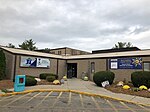Fall Creek Academy
Charter schools in IndianaIndiana school stubsPublic high schools in IndianaPublic middle schools in IndianaSchools in Indianapolis
Fall Creek Academy was a free public charter school for grades 6–12 in Indianapolis, Indiana. It offered a "Middle College" program that allowed qualifying high school students to take college courses for college credit at no additional cost while still enrolled in high school.The school closed at the end of the 2014 school year because its charter authorizer, Ball State University, declined to renew, citing the school's poor academic performance.
Excerpt from the Wikipedia article Fall Creek Academy (License: CC BY-SA 3.0, Authors).Fall Creek Academy
North Capitol Avenue, Indianapolis Highland Vicinity
Geographical coordinates (GPS) Address External links Nearby Places Show on map
Geographical coordinates (GPS)
| Latitude | Longitude |
|---|---|
| N 39.803743 ° | E -86.161894 ° |
Address
Fall Creek Academy
North Capitol Avenue 2540
46208 Indianapolis, Highland Vicinity
Indiana, United States
Open on Google Maps








